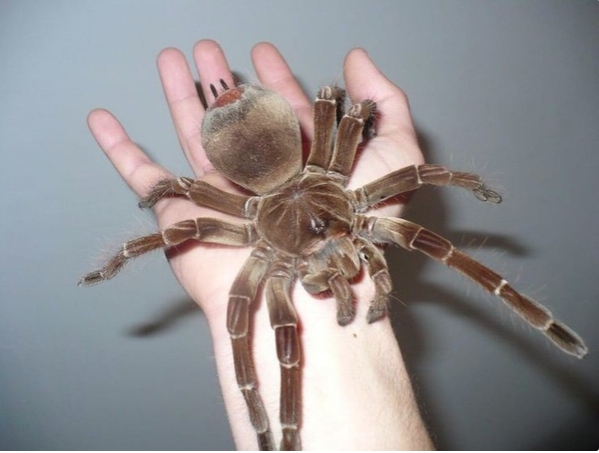One of the things I’ve noticed about spiders, is that people invariably exaggerate their size…sorta like…well…some other things* 👇.
Clearly, it’s human nature to exaggerate the good things in life. Sadly, though, most of the spider stories I hear being embellished are not presented as being Good Things™. Instead, the goal seems to be to enhance some unspoken degree of terror by enlarging the size of the threat.
So how big are spiders? Well, first off, when we “officially” measure spiders, it’s from the front of the cephalothorax (that’s the front end, exclusive of chelicerae or pedipalps) to the tip of the abdomen (excluding any spinnerets which may protrude).
Notice that legs don’t count!


This photo by Donald B. ZEPP is licensed under a Creative Commons Attribution-NonCommercial-ShareAlike 4.0 International License.
However, when speaking of The Largest Thing, we not only exaggerate, but, when spiders are the subject, people usually include the legs, presumably for effect. Thus, the largest spiders known are Theraphosa blondi (Latreille, 1804) which can measure 13cm (5.1in), but to make that even more impressive, add the legs , and it becomes 30cm (ca. 1 foot)–although if that’s what you’re counting, it ceases to be the world’s largest spider** 👇.

This photo is all over the ‘net, and I have not found the original to give it due attribution.
Of course, most spiders are small. In fact, about half of the known North American spider species*** 👇 are very small: less than 3mm long (about the thickness of three credit cards) at maturity.
Males of the smallest species known, Patu digua Forster & Platnick, 1977**** 👇, measure 0.37mm (about the diameter of a 0.015in guitar string, for my musician friends). In a classic bit of understatement, the species’ authors wrote of P. digua: “[their being] the world’s smallest known spider[s] makes working with them difficult; many characters…are difficult or impossible to resolve…and can be seen in detail only with [a] scanning electron microscope.”
Just think: It would take ca. 810 P. dagua lined up***** 👇end-to-end (no legs) to reach from one end of T. blondi’s legs to the other.
*👆 Fish. Yeah, that’s what I was thinking of! Fish. **👆 If we’re counting legspan, the largest known spider is a huntsman found in Laos: Heteropoda maxima Jäger, 2001, the legspan of which can exceed a foot. ***👆 N.B. the number of individuals in those small species vastly exceeds the numbers of individuals in the larger species. ****👆 Patu digua is in the family Symphytognathidae–they’re all small. In fact, Lehtinen (1975) wrote: “the Symphytognathidae… is surely a polyphyletic dump heap of minute Araneoidea.”
*****👆 I said “lined up” rather than “standing,” because we’re not counting legs, so how could they be standing? References:
Bradley, Richard A. 2013. In Common Spiders of North America. (1st Edition. University of California Press; Berkley & Los Angeles, California, USA) p.4. Forster, R. R. & Platnick, N. I. 1977. A review of the spider family Symphytognathidae (Arachnida, Araneae). American Museum Novitates 2619: 1-29.
Lehtinen, Pekka T. 1975. Notes on the phylogenetic classification of Araneae. Proc. Sixth Internatl. Arachnol. Congr., pp. 26-29, figs. 1-24.
